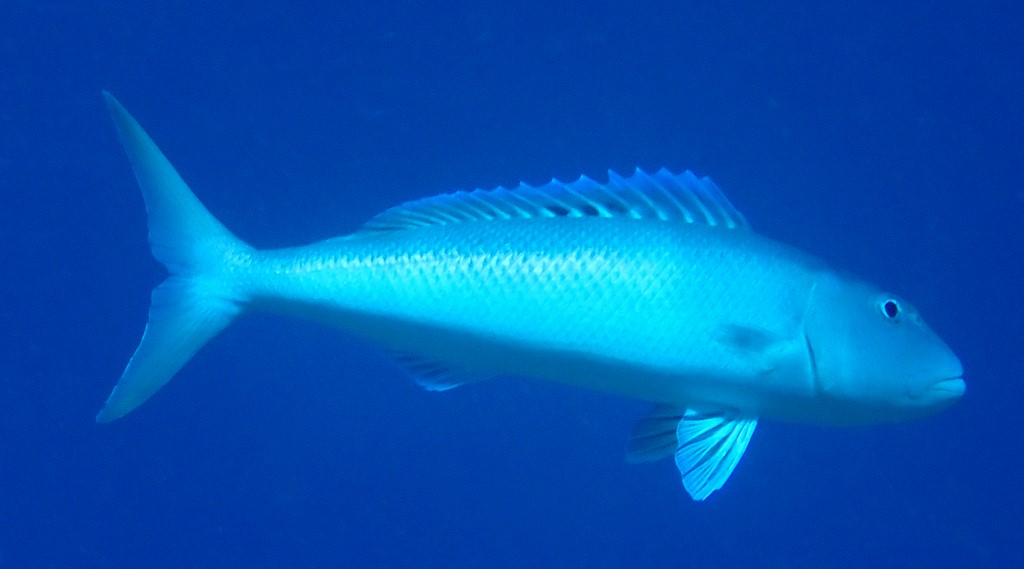APRION VIRESCENS - (VALENCIENNES, 1830)
Picture courtesy of: Alain Daoulas
Actinopterygii (Gigaclass) > Actinopteri (Class) > Teleostei (Subclass) > Acanthuriformes (Order) > Lutjanidae (Family) > Etelinae (Subfamily) > Aprion (Genus)
Vivaneau vert, Vivaneau job, Aprion verdâtre, Poisson job, Mékoua vert, Green jobfish, Jobfish, Job-fish, Green job-fish, Groen-jobvis, Aochibiki, Pargo verde, アオチビキ, 綠短鰭笛鯛, 藍笛鯛, عصموديّ أخضر,
Synonymes
Aphareus virescens (Valenciennes, 1830)
Aprion kanekonis (Tanaka, 1914)
Aprion konekonis (Tanaka, 1914)
Aprion viresceus (Valenciennes, 1830)
Aprion virescens placidus (Whitley, 1937)
Mesoprion microchir (Bleeker, 1853)
Sparopsis elongatus (Kner, 1868)
Sparopsis latifrons (Kner, 1868)
------------------------
Description
Dorsal spines (total): 10; Dorsal soft rays (total): 11; Anal spines: 3; Anal soft rays: 8; Pectoral fin rays: 16-18; Gill rakers on first gill arch: 7-8 + 14-16 = 21-24; Tubed lateral line scales: 48-50; Body depth: 3.7-4.5 in SL; Head long: 3.0-3.3 in SL. Body elongate and robust; Very distinct horizontal groove on snout ventral to nostrils; Teeth in both jaws in bands, with strong canines anteriorly; Teeth on roof of mouth in chevron- or crescent-shaped patch on vomer and in elongate band on each palatine; Maxilla without scales or longitudinal ridges; Interorbital region flattened; Preopercular edge smooth, sometimes denticulated in juveniles; Last soft ray of both dorsal and anal fins well produced, longer than next to last ray; Caudal fin forked; Short pectoral fins, less than 1/2 length of head, about equal to length of snout; Membranes of dorsal and anal fins without scales. Max. length: 112.0 cm TL, common length: 90.0 cm TL. Max. published weight: 15.4 kg; Max. reported age: 32 years. Depth range: 0 - 180 m.
Color
Head and body dark blue-green dorsally, sides iridescent bluish purple or rarely silvery; Scales with pale margins; Rear interspinous dorsal fin membranes dark basally.
Etymology
Aprion: from Greek prefix, a- = without + from Greek, prion, -onos = saw. Referring to smooth (unserrated) preoperculum.
virescens: from Latin, virēscō = I become green, become verdant. Referring to dark-green to bluish body color.
Original description: Aprion virescens Valenciennes, 1830 - Type locality: Seychelles, western Indian Ocean.
Head and body dark blue-green dorsally, sides iridescent bluish purple or rarely silvery; Scales with pale margins; Rear interspinous dorsal fin membranes dark basally.
Etymology
Aprion: from Greek prefix, a- = without + from Greek, prion, -onos = saw. Referring to smooth (unserrated) preoperculum.
virescens: from Latin, virēscō = I become green, become verdant. Referring to dark-green to bluish body color.
Original description: Aprion virescens Valenciennes, 1830 - Type locality: Seychelles, western Indian Ocean.
Distribution
Red Sea; Indo-West Pacific: Eastern Cape and KwaZulu-Natal (South Africa), East Africa, Persian Gulf, Socotra (Yemen), Seychelles, Comoros, Madagascar and Mascarenes (La Réunion, Mauritius, Rodrigues), east to Hawaiian Islands (U.S.A.) and Marquesas Islands (French Polynesia), north to southern Japan, south to Western Australia, New South Wales (Australia), New Caledonia, Lord Howe Island (Australia), and Tonga.
Biology
Adults inhabit open waters of deep lagoons, channels, or seaward reefs. Found in benthopelagic waters. Usually seen singly, but also in groups. They feed mainly on fishes, but also on shrimps, crabs, cephalopods and planktonic organisms. Mainly marketed fresh but also dried and salted. Excellent eating. Large individuals may be ciguatoxic.
Similar species
Aphareus rutilans (Cuvier, 1830) - Reported from New Caledonia - Link to the species (here). Aprion virescens differs from Aphareus rutilans in having dark patches along dorsal-fin base, a blunter snout, and a less deeply forked tail.
Last update: 26, August 2024
Biology
Adults inhabit open waters of deep lagoons, channels, or seaward reefs. Found in benthopelagic waters. Usually seen singly, but also in groups. They feed mainly on fishes, but also on shrimps, crabs, cephalopods and planktonic organisms. Mainly marketed fresh but also dried and salted. Excellent eating. Large individuals may be ciguatoxic.
Similar species
Aphareus rutilans (Cuvier, 1830) - Reported from New Caledonia - Link to the species (here). Aprion virescens differs from Aphareus rutilans in having dark patches along dorsal-fin base, a blunter snout, and a less deeply forked tail.
Last update: 26, August 2024
